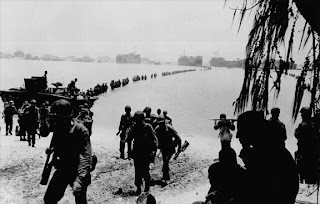Times Square Celebration
August 14, 1945
Iva Toguri d'Aquino
Secretly, Toguri took instruction in Catholicism. On a sunny spring day, April 19,1945, Iva Toguri married Felipe d’Aquino. The only hitch in the festivities was a bombing raid that forced the wedding party to take refuge in a shelter. Toguri and d’Aquino had little time for romance. Death rained from the sky as B-29s unmercifully hammered Tokyo. Thousands perished. Survivors prayed they would live one more day.
On August 6, a single B-29 Superfortress, the Enola Gay, dropped an atom bomb nicknamed “Little Boy” on the industrial city of Hiroshima. Three days later “Fat Man,” a second atom bomb, was dropped on Nagasaki. Anybody within a mile radius of the each explosion was vaporized. Others burned to death, and still others succumbed to radiation sickness. In all, an estimated 300,000 Japanese, mostly civilians, were killed. Release of the most destructive weapon ever conceived had the desired effect. Emperor Hirohito declared that Japan must “endure the endurable” and surrender. On September 2, 1945 Japanese officials signed a formal surrender document on the deck of the U.S.S. Missouri in Tokyo Bay. World War II was over.
Toguri was elated. Finally, she could return to America with her husband. The troubles of the last four years receded into the background as she and d”Aquino made plans for their future together. In the weeks following the Japanese surrender Tokyo swarmed with American correspondents looking for a scoop. There were three stories everybody wanted to get—an interview with General Hideki Tojo, a description of the Tokyo destruction, and an interview with Tokyo Rose. On August 31, a friend showed Toguri a newspaper story stating that two American correspondents were willing to pay $2,000 to interview “Tokyo Rose.” In war-ravaged Tokyo this was a small fortune, equivalent to over $24,000 in today’s currency.
Toguri had first heard the name “Tokyo Rose” in the spring of 1944. Around Radio Tokyo opinions differed about which of several female broadcasters matched the GI nickname. Various descriptions of Tokyo Rose didn’t fit one person. ‘She had a sultry voice’; ‘she broadcast on Sunday evening’; ‘she called herself Orphan Ann’. The Orphan Ann moniker fit Iva Toguri, but she did not broadcast on Sunday evenings; that was Ruth Hayakawa’s time slot. As for the voice, Toguri’s was decidedly not sultry. June Suyama, the Nightingale of Nanking, had a sultry voice, but she did news rather than music. No one at Radio Tokyo fully understood the heavy baggage that went with the name Tokyo Rose—least of all Toguri. She considered her broadcasts an entertaining diversion for GIs.
The cash-for-interview offer was stunning, but Felipe was dubious. He thought there was was something fishy about the offer. Why, he asked, were correspondents offering such a huge sum of money to interview a female radio broadcaster? He told his wife that the money might be a lure to snare a propaganda broadcaster. Maybe the American military did not view "Tokyo Rose" in the same favorable way Toguri thought of herself. Tokyo Rose was a melded personality made up of several different individuals, how could Toguri be sure that the reporters would accept her rather than June Suyama or Ruth Hayakawa? Despite Felipe’s concerns, she was determined to do the interview and collect the money. There were other female announcers who could claim the title “Tokyo Rose”. As far as Toguri was concerned, there was no risk. She and Major Cousens had labored over scripts and her on-air delivery to mold Orphan Ann into a non-threatening buddy, who at worst teased GIs and at best boosted their morale.





